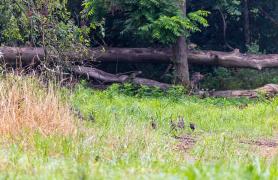
Before leaving for work on May 7, 1953, George Divelbiss, St. Joseph, had made it plain to his daughter, LaDonne Kieser, that she should stay home and relax. But LaDonne, nine months pregnant with Divelbiss’s first grandchild, decided otherwise.
Without her husband, Lester, a Marine aboard an aircraft carrier headed to Korea, LaDonne decided to join her mother, Wilma, on a check of the family’s cows and a short hike to look for morel mushrooms.
“I had never hunted mushrooms and heard dad talk about it many times, a longtime family tradition that added substance to meals during the tough depression years and for years before and after,” LaDonne said. “I was a bit nervous about having my first baby, so taking a walk and enjoying fresh air sounded good.”
The stroll over western Missouri’s rolling hills was indeed pleasant with wildflowers blooming and spring foliage busting out. Their cows, standing belly deep in sweet grass, looked fine, so the mushroom hunt began.
“We started finding morels immediately, and mom had to do all of the bending over and picking,” LaDonne said. “I had sharp eyes and started spotting morels several yards away. We quickly found enough for a couple of meals and returned home.”
Early the next morning, LaDonne gave birth to her first son. Her father, still irritated that she’d ignored his admonition the previous day, sent a telegraph to Lester on the aircraft carrier USS Philippine Sea stating: “Your son safely arrived, in spite of his mother going mushroom hunting the day before.”
A Tradition Was Born
That first outing hooked LaDonne — May 7, 2023, will mark her 70th straight year of hunting Missouri morels.
After Lester’s return from the Korean War, they bought a 160-acre family farm between Easton and Gower, Missouri, from his dad. A good-sized stretch of woods provided new areas to hunt morels with family, friends, grandchildren, and now great-grandchildren.
Their most memorable hunt happened on a sunny April afternoon in 1977.
“Lester was ready to quit when something seemingly out of place on a distant creek bank caught my eye,” she said. “I walked over to find a large mushroom. Thinking there could be more on the hill, we climbed a steep creek bank and stopped dead in our tracks. The area was covered with morels over the flat ground, down into a ditch, back up the other side, and across more flat ground. Little grays and big yellow mushrooms seemed to be popping out of the soil.”
Lester walked a mile back to his pickup for more bags while LaDonne and her younger son Rodney continued picking. He returned to find several piles of mushrooms stacked in different spots and they still had more to pick. They harvested several hundred mushrooms by day’s end — a phenomenon never repeated on that property.
Years later, LaDonne walked three hours without finding a mushroom. She sat to rest on an elevated log, looked down and saw at least 30 morels below her perch stretching down a creek bank. She could always find at least a couple of mushrooms, even during severe dry weather conditions.
Now 92, LaDonne moves considerably slower and is slightly bent over from osteoporosis. Her days of hunting numerous acres are now down to less than an acre with help from her sons.
“Even today it’s uncanny how many morel mushrooms she will find,” said Rodney Kieser, her youngest son. “Moving slower with age seems to have made her even more efficient. Few are better at finding morel mushrooms, she generally finds the most.”
LaDonne’s Tips and Wise Words
Start looking for little gray morels about the first week of April and into May, LaDonne suggests. Go out when air temperature reaches at least a constant 55 degrees overnight. The first morels each season are small grays, and bigger mushrooms will appear a week or two later. Half-grown mayflowers are a good indicator of the required soil warmth when early morels start to appear. Early in the season means less ground vegetation and morels are easier to find.
“Try looking after a warm spring rain when conditions are favorable,” LaDonne said. “You may not find mushrooms, but it is a great time to pick Sweet William flowers to make your house smell good. Pick them close to your vehicle and have a vase of water ready because they wilt quickly.”
Everyone has their own favorite mushroom spots. Check there but find new spots where you’ve never thought of looking, LaDonne advises. Spores float through the air and morels are where you find them.
Dying elm trees produce a rotting root system, and we have found morels in these areas, but only for a year or two, LaDonne said. Apple trees with constantly rotting fruit may produce morels. Look around ash, aspen, and oak trees. Areas with good leaf matting or trees that drop their leaves and bark earlier in the fall have longer to decay and sometimes produce. Light-colored barked trees like birch, sycamore, and cottonwoods are good examples.
Early-season hunters should first check southern hillsides and creek bottoms open to sunlight that quickly warms the soil. Warming trends sometimes make eastern areas productive.
Burn areas can be good for producing morels.
“We found several for two years on a freshly burned section of timber after lightning started a fire,” LaDonne said.
People look straight at a morel mushroom after hunting a while and don’t see it. Sometimes look away and then back at a likely area. Your eyes may focus on a mushroom. Train your eyes and mind to see morels and you will. Otherwise, you will only see acres of vegetation.
“Slow down and look at every spot,” LaDonne said. “Most people move too fast, generally lacking patience. This is not a race, so back off and enjoy the day. I sometimes look in a small area several minutes.”
Did you spot one morel? You are taller than the surrounding forage, so LaDonne suggests kneeling or sitting down to study the ground. She says you will find another mushroom and sometimes several.
“Always carry a walking stick to push aside foliage,” LaDonne said. “Sometimes you’ll uncover a snake. Come back later or gently push the snake aside with your stick and it will crawl away. Don’t hurt snakes — they eat insects and rodents.”
You will need a good pair of walking boots, light colored clothing to make ticks more visible, and a mesh bag — hopefully two or three bags.
“We carry mesh bags to gather morels and release spores for growing future mushrooms,” LaDonne said. “We use the same bag over and over, season after season, without washing. The rough material of the bag releases spores. Some stay in the mesh and release later.”
Be aware you are sharing the woods with others.
“Be cautious during turkey season,” LaDonne said. “I wear my son’s orange deer hunting vest and make a lot of noise.”
Very little moisture in late winter and early spring can hurt morel mushroom growth. Do you have a spot close to home where morels grow? If so, wet it down occasionally with fresh water. This works, but not always.
At the end of a good morel hunt, an all-over body check is a must.
“You may not find mushrooms, but the ticks will find you,” LaDonne said. “Always do a complete tick check at days end. I sold cosmetics years ago and found ticks hate perfumed scents like rose, lavender, peppermint, or lemon.”
LaDonne’s Rules for Taking Children Mushroom Hunting
Talk about mushroom hunting with your child so they will want to try it, LaDonne suggests, and make the first trips about having fun. Pick your weather carefully when taking a child mushroom hunting. They will stay longer on a beautiful day.
“When you can’t find mushrooms and they are getting bored, take them home,” LaDonne said. “You can return later.”
If your child wants to explore, let them look around in a safe area while staying in your sight. A child almost never has an adult’s patience.
Let your child pick the mushrooms you find. Show them how to pinch low on the stem. This will make them want to find more. Teach them the difference between true morels and false morels. False morels have solid caps and look a bit different. Make sure everyone knows that false versions can make you sick.
Once you get home, encourage your child to help cook and taste the mushrooms for the full experience.
For more information about morels and other Missouri mushrooms, consult A Guide to Missouri’s Edible and Poisonous Mushrooms at short.mdc.mo.gov/ZNf or order a free copy at short.mdc.mo.gov/4Yq.
Cooking Tips
“Years ago, we soaked morel mushrooms in saltwater like fish, but that doesn’t work,” LaDonne said. “Preparing morel mushrooms is simple. Start by soaking morels in clean water a couple of hours then make sure to wash out any bugs living inside. I slice them lengthwise in half to be safe. Try cutting your morels in little pieces to mix in omelets. Most mushroom hunters cut each morel in half and dip them in eggs before frying in cornmeal, flour, or crushed crackers. Either way, fry until golden brown and don’t invite company that night.”


















Also In This Issue

Practical tips for hitting the ground running.

Timber stand improvement and habitat management benefits turkeys and other species.
And More...
This Issue's Staff
Editor - Angie Daly Morfeld
Associate Editor - Larry Archer
Photography Editor - Cliff White
Staff Writer - Kristie Hilgedick
Staff Writer - Joe Jerek
Staff Writer – Dianne Van Dien
Designer - Shawn Carey
Designer - Marci Porter
Photographer - Noppadol Paothong
Photographer - David Stonner
Circulation - Laura Scheuler






















